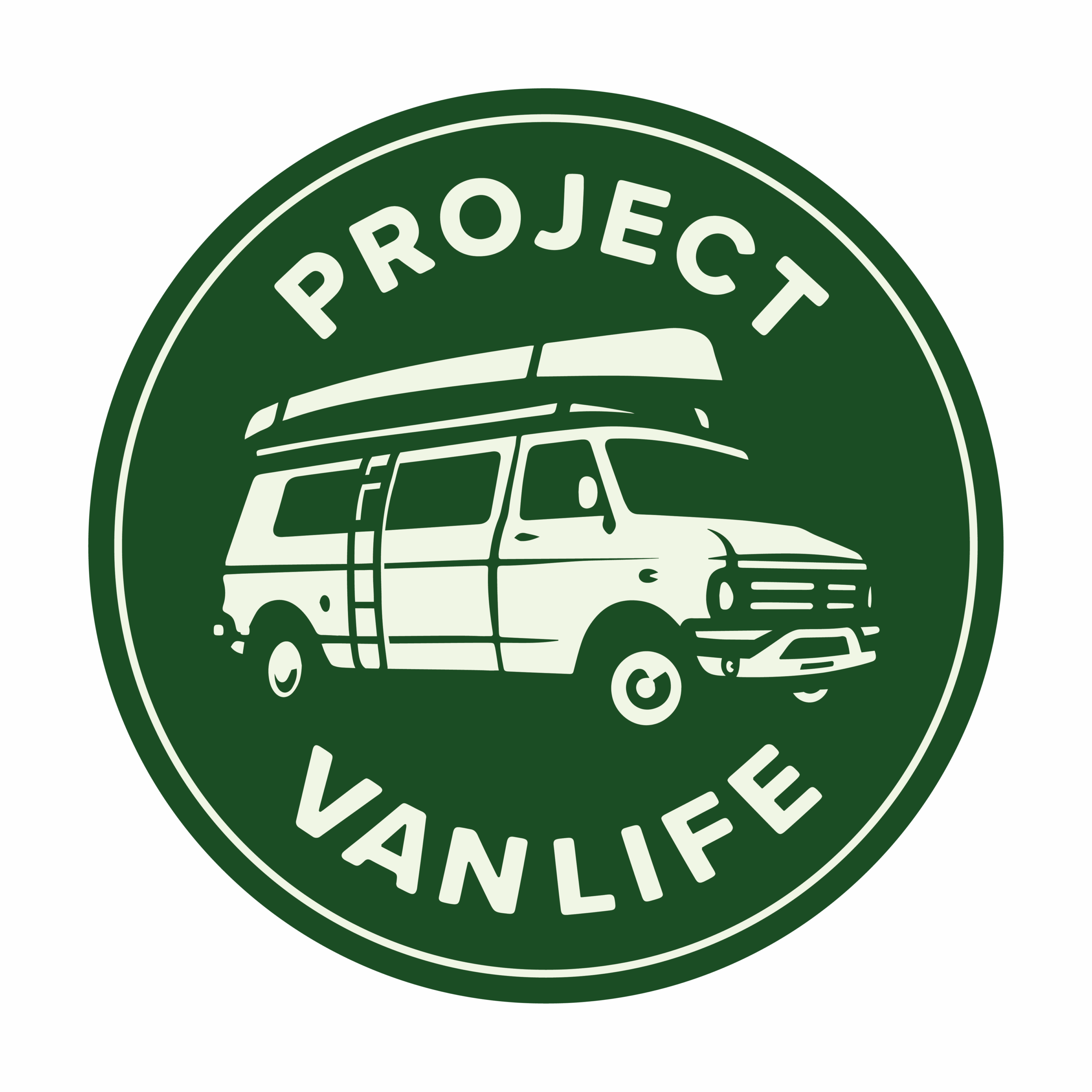Introduction
I’m a 30-years veteran of military aviation. Presently I am in semi-retirement working during the summer doing aerial forest fire fighting.
I am divorced with three children who I raised by myself for the last 15 years. At this time, they are all capable adults and on their own paths.
Therefore, after many years, I find myself free to pursue whatever I choose. That’s how the adventure began…
An Idea Takes Shape
When I asked myself what I really wanted, the answer was simply to go see my friends. I’ve made a handful of really good friends over the years but they are all a long way away and I haven’t seen most of them for a long time. I wanted to go see them, but not for just a visit. I wanted to live in their lives again for a while. Now it isn’t any good to stay in someone’s place too long; that just gets uncomfortable for everyone. But being a neighbor is fine. So I thought to myself that I needed some kind of RV that I could drive to where they live, and then live beside them for a while.
Well that’s nice, but my friends all have lives and they aren’t going to drop everything and hang out with me all the time when I’m down there. So while I’m there I’d need something else to do besides visit. Like what?
I really love motion, which is not surprising for a pilot. So in addition to flying, I love riding my motorcycle and my bicycle. I also like working out, camping, scuba diving and any other fun adventure that comes along. (I also discovered that I like writing but we’ll get to that later.) So I thought, if I’m driving down there anyway, can I bring some of this stuff with me to have fun while I’m there?
While I’m at it, I also wanted to live as comfortably on the road as I did at home. I wanted good meals I cooked myself, a decent bed, lots of entertainment options, and a hot shower from time to time.
One more thing. I didn’t have infinite money. I needed to be frugal going into retirement. I might just live a few more decades and I didn’t want to have to eat dog food towards the end.
Engineers call all those ‘wants’ design drivers. With my design drivers I set out to engineer my solution.
Poking Around
The first thing I thought of was a used Class C motorhome. Spacious, already built, relatively cheap; I could tow a trailer behind it for the toys. Problem is, if you’re visiting your friends for a month, there are a lot of bylaws that say you can’t park a Class C motorhome on the street for that long. It just isn’t very flexible.
Okay, how about a Class B motorhome? Not quite as spacious, but you can park it anywhere. It’s just a van right? Well holy mackerel but those things are expensive. New is astronomical, and even used is crazy. Plus, the way they’re designed isn’t particularly suited to what I wanted. Nope.
I looked at Toy Haulers briefly. That combines the trailer and living space in one. They didn’t really suit what I wanted in terms of payload and even though I love my motorcycle, that doesn’t mean I want to sleep beside it.
So it came down to doing my own conversion van with a trailer. I could make it comfortable for what I want, park it anywhere, get it for an affordable price, and tow a trailer with the toys. Off we go…
Starting the Conversion
Before embarking on the conversion, I fleshed out the detailed design drivers. I wanted:
- Everything is to be fixable with normal tools and hardware supplies on the road.
- To be able to rip everything out and return the vehicle to cargo van status in case this didn’t work out and I needed to sell it.
- A comfortable bed.
- A place to store and prepare the usual nutritious, if not Spartan, meals that I enjoy.
- Be tall enough to walk around in without stooping. (I’m 6’)
- Have enough power to tow a 3200lb trailer through the mountains.
- Fit a home stall shower capable of hot running water showers. (Big Driver!)
- Have clean power; enough to run my computer (since I do work in support of my video editing on the road along with so much else), lights, microwave, stove element, powered cooler, and (dun dun dah) a water heater.
- A water system that is gravity powered for my kitchen/bathroom sink and has some pressure for the shower with hot and cold water. The water source has to be easy to refill and carry.
- Insulation to reduce the heat, but not protect from the cold. That is, the van will only be occupied when the outside temperature is above freezing.
I didn’t care about:
- How pretty it is.
- How complicated it is.
- How cramped it is or what kind or contortions I have to do to move around and get stuff.
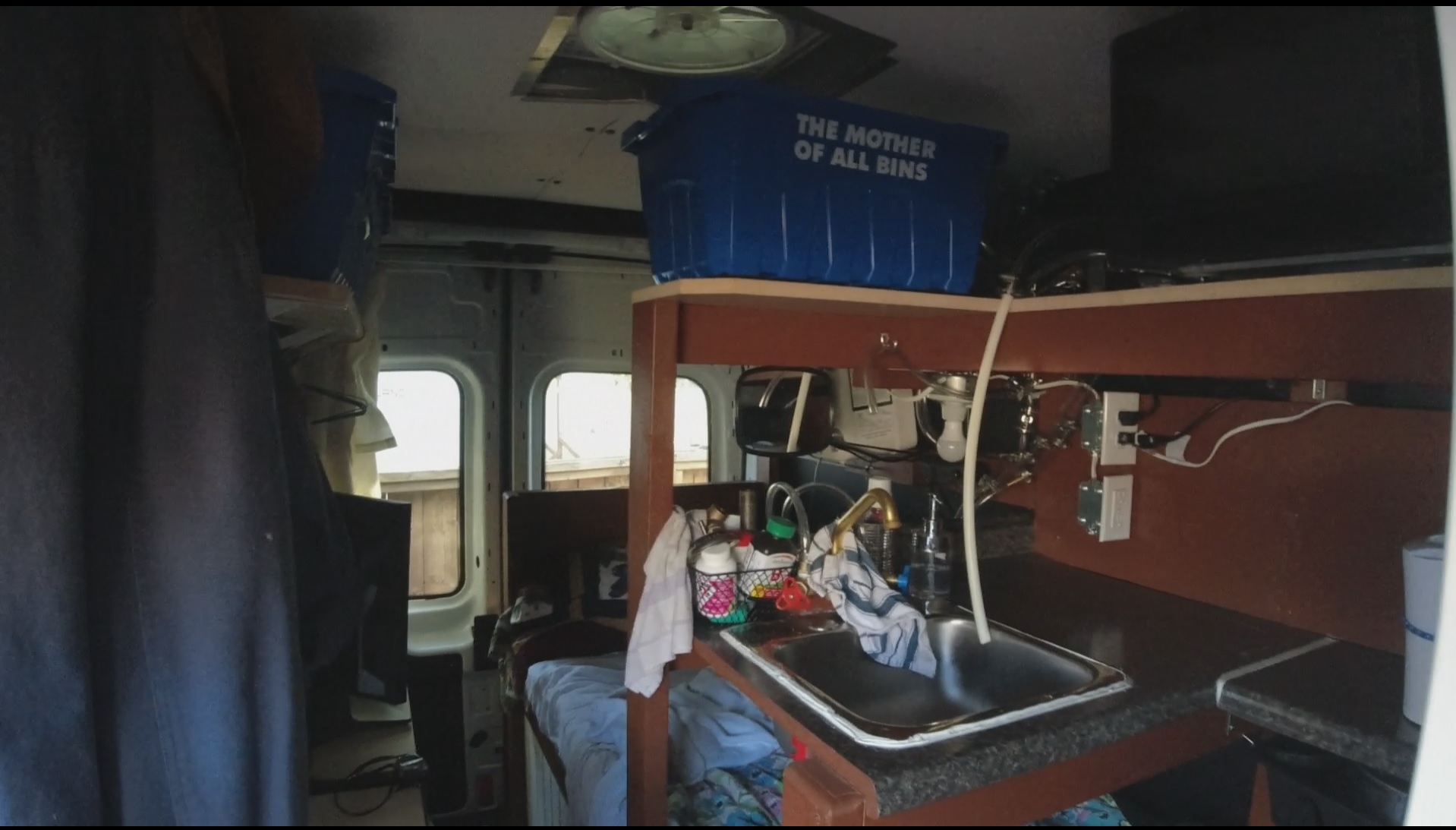
Building the System
A picture is worth a thousand words, so I would refer you to the walk-through video I included to see a detailed look on how I solved the engineering. Here are some high points to note:
- A Ford Transit was the way to go for the height. I would have preferred the long body cab for the additional 2’ but had to settle for the extended body due to availability in my area at the time. It was probably for the best in the end because the van just fits in my driveway as it is. The Transit also has the towing power I need for the trailer.
- I had a custom foam mattress made to the specifications I needed. This wasn’t expensive, allowed me flexibility in the design, and is super-hard which is exactly what my back loves.
- There were pre-tapped holes in the walls of the van. I used them to bolt two 2X4’s lengthwise down the van. All the interior structures are bolted to these 2X4 ‘runners’ and to the ¾” plywood floor I set down. This turns out to be very rigid and can be removed easily since there are no lasting changes to the structure of the van. This helps with insurance too by the way.
- For insulation I just stuffed fiberglass behind the pre-existing wall cardboard panels and ones I made on my own for the ceiling. There is no vapour barrier so this is not designed for sub-freezing temperatures.
- I had my mechanic install a MaxxAir ceiling fan for me. This is a must. I put in a switch to either run it off the vehicle battery or the interior electrical system. Either way, make sure you buy and install a voltage regulator to keep the supply voltage below 12V or you’ll damage the control board on the fan. This is a known defect and irritating.
- I also had my mechanic install the towing package including brake controller. He did a great job.
- For clean power you need a pure sine wave inverter and they aren’t cheap; but they perform as advertised. Powering my inverter is two banks of two deep cycle 12V batteries. One bank will get you through a day of normal electrical use. To charge the batteries I built in several options: 1) shore power, ie. plug into any normal household 120V 15A outlet; 2) generator, I have a little portable one; 3) two movable solar panels; 4) the alternator of the van motor.
- For water, I use standard 5 gal bottles. I keep 2 in the van and 4 in the trailer. I just fill them from any potable water source. I made a bracket that holds the source water bottle near the ceiling so the sink gets water simply by gravity power.
The Trailer
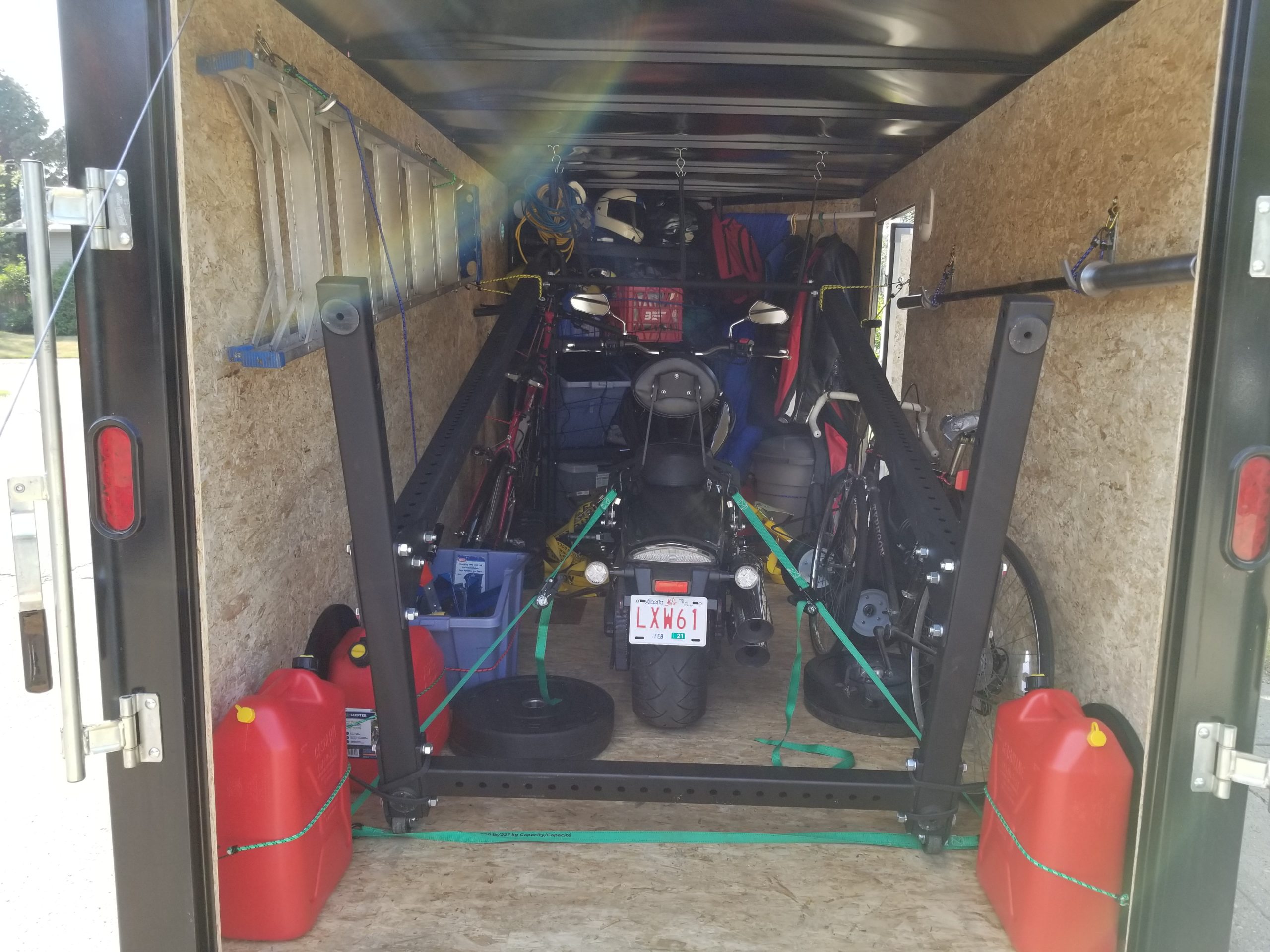
The trailer is as important as the van. It carries my Yamaha Raider 1850 which weighs 700lbs, my road bike, my trash bike, motorcycle gear, cycling gear, a weight rack, free weights, camping gear, scuba gear, extra gas, extra water, and a host of handy tools just in case. Total payload for the trailer is about 1700 pounds and the trailer weight itself is 1500 pounds so it’s hefty at 3200 lbs total weight. That means a double-axle trailer with electric brakes. Man, is it ever nice to be able to take my motorcycle to where the cool riding is, without having to spend days in the rain to get it there.
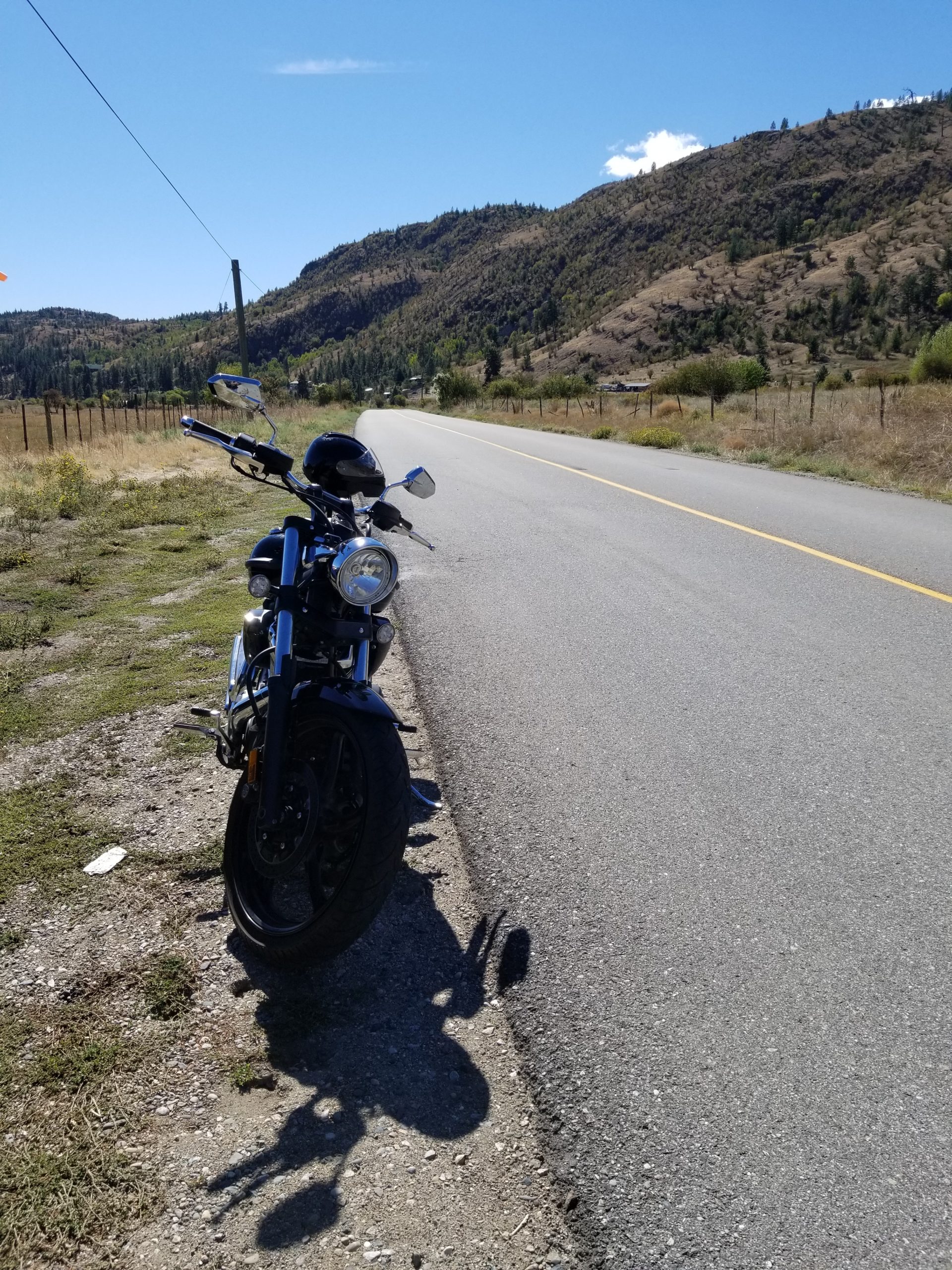
Life on the Road
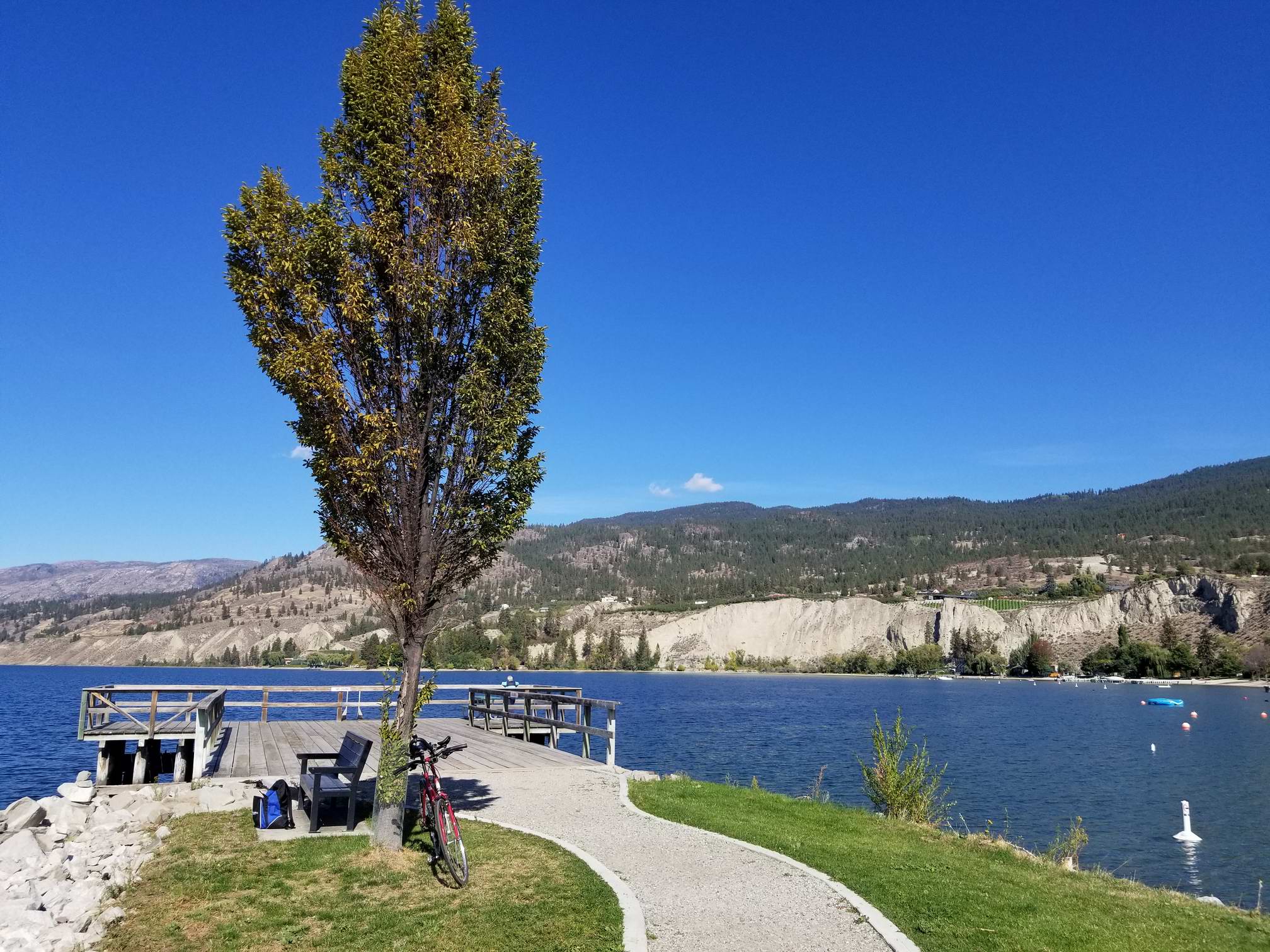
I’m probably not typical for this forum in that I maintain a house as a residence (mostly as a place for my adult children to live while they attend university) and I also work seasonally to support us. So I have a home base to return to and I don’t live in the van for more than a month at a time. I must say though that I enjoy that time immensely. Living isn’t quite as easy as in a house, but it is much simpler, much quieter, and it’s so awesome to see new things and play out in the world. And the initial idea is coming true; I’m finally getting to see my friends again!
Videography
I decided to make some videos of the adventures I have on the road. It started as just wanting to make cycling videos on cool rides that I could watch later on my stationary trainer during the winter. Then the idea just grew. So now the videos are about cycling, motorbiking, and working out in new places down the road.
But that’s not all. I discovered another creative pursuit while I had the time to just be with myself; writing. I published my first story recently. For fun I narrate the chapters on videos I make from different locations in my home town of Edmonton in the wintertime. You can’t be on the road all the time; at least not yet...
I found out that I really enjoy the technical and artistic aspects of trying to make a good video. If you’re interested, you can see what I’ve been up to at ‘Unchained Skid’ on YouTube.
Magic Time
When I was young I had health and time but no money. When I was middle-aged I still had health and now I had money, but I had no time. Now, in this all too brief a period; I have time, money, and health. The arthritis in my hands as I type this reminds me that this isn’t going to last too much longer. So I’m going for it with all I’ve got.
What’s in a Name?
When I was flying fighter jets way back in the day, my call-sign was ‘Skid’. Why ‘Skid’ is a story for another time, but it stuck. And as you can tell from my intro, I’m now unchained. There you go…
Last Word
Ferris Bueller said it best, “Life moves pretty fast. If you don't stop and look around once in a while, you could miss it.”
Here’s to stopping and looking around.
Skid
